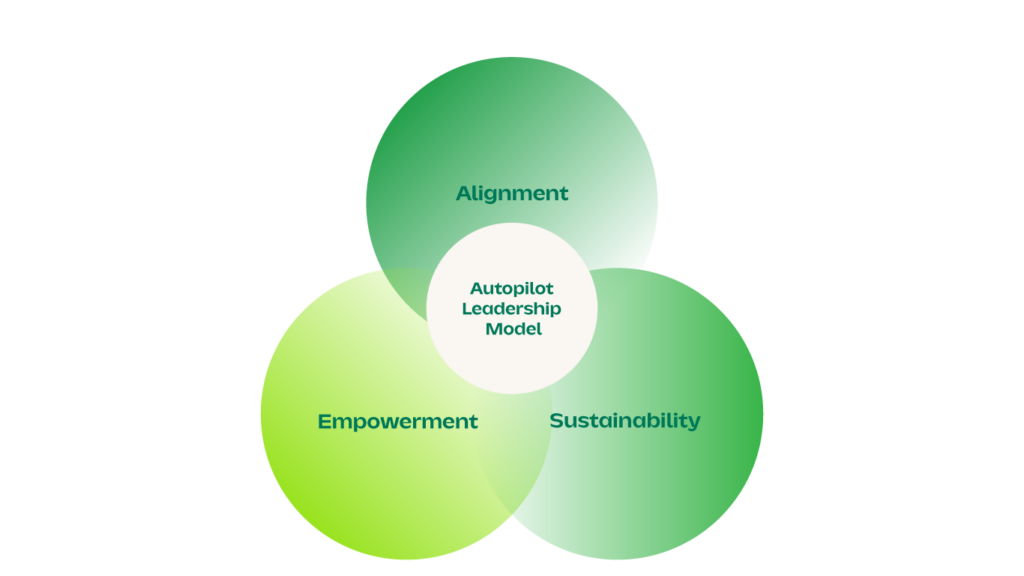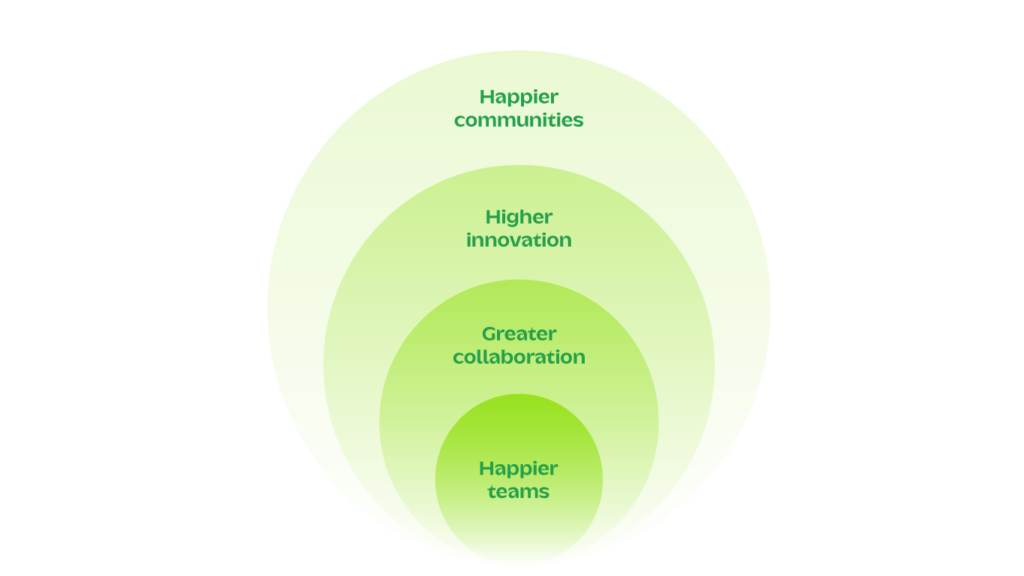
Why happiness is more than a buzzword
In today’s fast-paced, high-stakes business environment, leaders often find themselves operating on “autopilot” – juggling endless tasks, driving outcomes, and striving to meet ever-increasing expectations. But what if being on autopilot wasn’t a default reaction to stress, but instead a deliberate leadership framework designed for clarity, efficiency, and impact?
The Autopilot Leadership Model™, created by Sammy Lee, Executive Chairman of Lee Kum Kee Group, and developed through the Autopilot Leadership Lab (ALLab) since 2016, seamlessly integrates traditional Eastern wisdom with modern Western management practices. This innovative framework equips leaders to achieve a balance between control and delegation, enabling teams to operate autonomously while leaders focus on strategic growth.
Inspired by Lao Zi’s Dao De Jing and the concept of the “Invisible Leader,” the model emphasizes clarity, direction, and minimal intervention. By empowering employees to make decisions, it unlocks their potential, boosts efficiency, and fosters a harmonious workplace. This not only elevates the “Happiness Index” but also ensures business sustainability and long-term success.
Sammy Lee developed this model from his leadership experiences and insights into common challenges faced by leaders. His pragmatic approach combines structure with flexibility, empowering leaders to navigate today’s fast-paced and complex environments with confidence and impact.
The Autopilot Leadership Model™ embraces the idea that when systems, teams, and leaders are aligned, the mechanics of great leadership can flow seamlessly. At its core lies a principle that’s often overlooked or reduced to a buzzword: Happiness.
Happiness in leadership isn’t about fleeting moments of joy or superficial perks. It’s about cultivating an environment where people thrive, purpose aligns with action, and long-term success is fueled by well-being. Leaders who prioritize happiness as a strategic driver see its impact ripple through every aspect of their organizations – boosting creativity, productivity, and resilience.
The Autopilot Leadership Model™ recognizes that happiness isn’t an accident – it’s a mindset, a practice, and a measurable element of organizational health. And when leaders embed happiness into their leadership style, they unlock the full potential of their teams and themselves.
Why settle for reactive leadership when you can lead with purpose and joy?
Let’s explore how the Autopilot Leadership Model™ can help you build a happier, high-performing organization.

The Autopilot Leadership Model™: The key to a happier workplace – and a happier world
What Is the Autopilot Leadership Model™?
The Autopilot Leadership Model is a framework that enables leaders to create systems, processes, and cultures that function seamlessly and allow teams to thrive. Far from being a hands-off or passive approach, it is a deliberate way to lead with clarity, purpose, and balance. The model operates on three foundational pillars:
- Alignment – Ensuring that individuals, teams, and the organization share a clear sense of purpose and direction.
- Empowerment – Trusting and equipping teams to take ownership of their work and flourish independently.
- Sustainability – Prioritizing well-being to create a positive, enduring workplace culture.
Together, these pillars foster an environment where happiness can flourish – an environment where people feel motivated, valued, and connected.
How the Autopilot Model™ drives happiness
- Alignment creates meaningful work
When people understand how their roles contribute to larger goals, their work becomes meaningful. Clarity of purpose fosters pride and satisfaction, which are key drivers of happiness.
Example: Teams aligned with a clear mission are more likely to feel connected to their work, reducing stress and increasing fulfillment. - Empowerment builds confidence and trust
Empowered teams feel trusted and capable. By delegating responsibility and supporting autonomy, leaders allow individuals to grow, innovate, and take ownership of their success.
Example: When employees have the freedom to make decisions and contribute creatively, they experience higher job satisfaction and a greater sense of achievement. - Sustainability supports well-being
Happiness thrives in environments that prioritize balance and resilience. Leaders who actively foster a sustainable workplace – by valuing mental health, promoting work-life balance, and celebrating success – cultivate teams that are energized and engaged.
Example: Recognizing and celebrating team wins fosters positivity, while encouraging breaks and flexibility reduces burnout.

The ripple effect: From workplace to world
A happier workplace doesn’t just benefit the people within it – it ripples outward. When employees experience fulfillment and joy at work, they carry that energy into their communities and personal lives, influencing those around them. By adopting the Autopilot Leadership Model, leaders aren’t just creating better workplaces – they’re contributing to a better world.
Consider the impact:
- Happier teams → Greater collaboration: Positive workplaces foster stronger relationships and open communication.
- Happier teams → Higher innovation: Teams that feel supported are more willing to take risks and think creatively.
- Happier teams → Happier communities: Employees who feel good at work spread positivity beyond the office, enriching their personal relationships and communities.
The happiness multiplier effect
The Autopilot Leadership Model makes happiness a sustainable, scalable outcome by embedding it into the organization’s DNA. With aligned goals, empowered individuals, and a focus on well-being, happiness becomes a natural byproduct of day-to-day operations.
This creates a happiness multiplier effect:
- Teams thrive, perform better, and feel valued.
- Leaders experience less stress and greater satisfaction.
- Organizations attract and retain top talent, building momentum for long-term success.
Why happiness matters in leadership
Happiness is often seen as a “nice-to-have” in business, but it’s actually a key driver of success. Research consistently shows that happy employees are:
- 12% more productive,
- 3 times more creative, and
- 87% less likely to leave their jobs.
In the Autopilot Leadership Model, happiness isn’t an afterthought – it’s a measurable, intentional goal. By focusing on happiness, leaders:
- Enhance team resilience and adaptability.
- Reduce turnover and create lasting loyalty.
- Drive innovation and continuous improvement.
Co-creating a happier world
The Autopilot Leadership Model recognizes that happiness isn’t just the responsibility of individuals – it’s a shared effort between leaders and their teams. By co-creating environments where happiness can thrive, leaders inspire their teams to reach new heights while contributing to a larger movement toward well-being in society.
What happens when more organizations embrace this approach?
We begin to shift workplace cultures, making happiness a priority in business and beyond. Leaders who adopt the Autopilot Model are helping to build a world where success and well-being go hand in hand, and where people can flourish both professionally and personally.
Take the first step toward Happier leadership
The Autopilot Leadership Model offers a roadmap for leaders who want to make happiness the cornerstone of their strategy. By fostering alignment, empowerment, and sustainability, you’re not just leading more effectively – you’re building a legacy of joy, purpose, and connection.
Let’s work together to create happier workplaces, one team at a time – and, in doing so, a happier world.
Read more:
The Autopilot Leadership Model – Sammy Lee